check engine JEEP WRANGLER 2012 JK / 3.G Owner's Manual
[x] Cancel search | Manufacturer: JEEP, Model Year: 2012, Model line: WRANGLER, Model: JEEP WRANGLER 2012 JK / 3.GPages: 613, PDF Size: 17.14 MB
Page 532 of 613
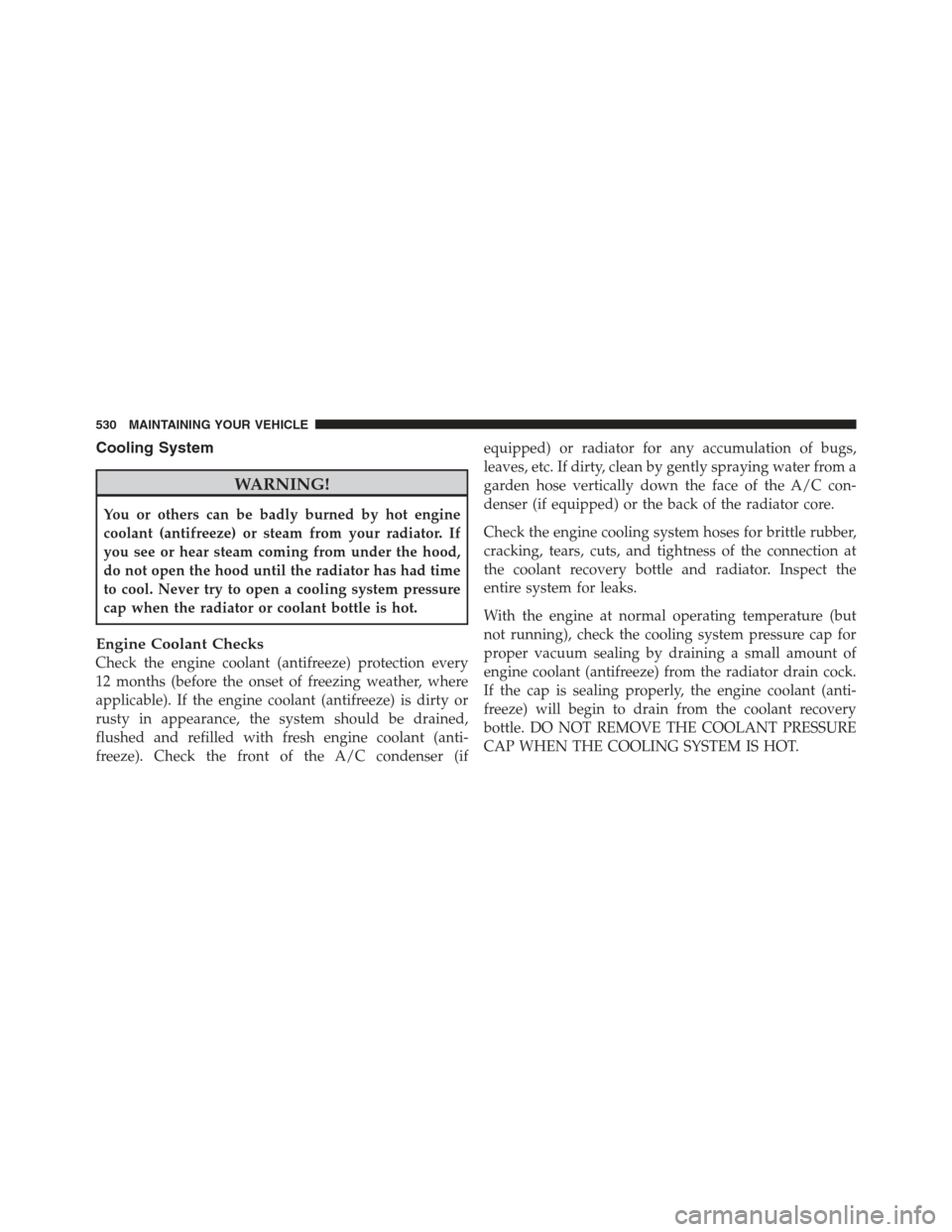
Cooling System
WARNING!
You or others can be badly burned by hot engine
coolant (antifreeze) or steam from your radiator. If
you see or hear steam coming from under the hood,
do not open the hood until the radiator has had time
to cool. Never try to open a cooling system pressure
cap when the radiator or coolant bottle is hot.
Engine Coolant Checks
Check the engine coolant (antifreeze) protection every
12 months (before the onset of freezing weather, where
applicable). If the engine coolant (antifreeze) is dirty or
rusty in appearance, the system should be drained,
flushed and refilled with fresh engine coolant (anti-
freeze). Check the front of the A/C condenser (ifequipped) or radiator for any accumulation of bugs,
leaves, etc. If dirty, clean by gently spraying water from a
garden hose vertically down the face of the A/C con-
denser (if equipped) or the back of the radiator core.
Check the engine cooling system hoses for brittle rubber,
cracking, tears, cuts, and tightness of the connection at
the coolant recovery bottle and radiator. Inspect the
entire system for leaks.
With the engine at normal operating temperature (but
not running), check the cooling system pressure cap for
proper vacuum sealing by draining a small amount of
engine coolant (antifreeze) from the radiator drain cock.
If the cap is sealing properly, the engine coolant (anti-
freeze) will begin to drain from the coolant recovery
bottle. DO NOT REMOVE THE COOLANT PRESSURE
CAP WHEN THE COOLING SYSTEM IS HOT.
530 MAINTAINING YOUR VEHICLE
Page 535 of 613
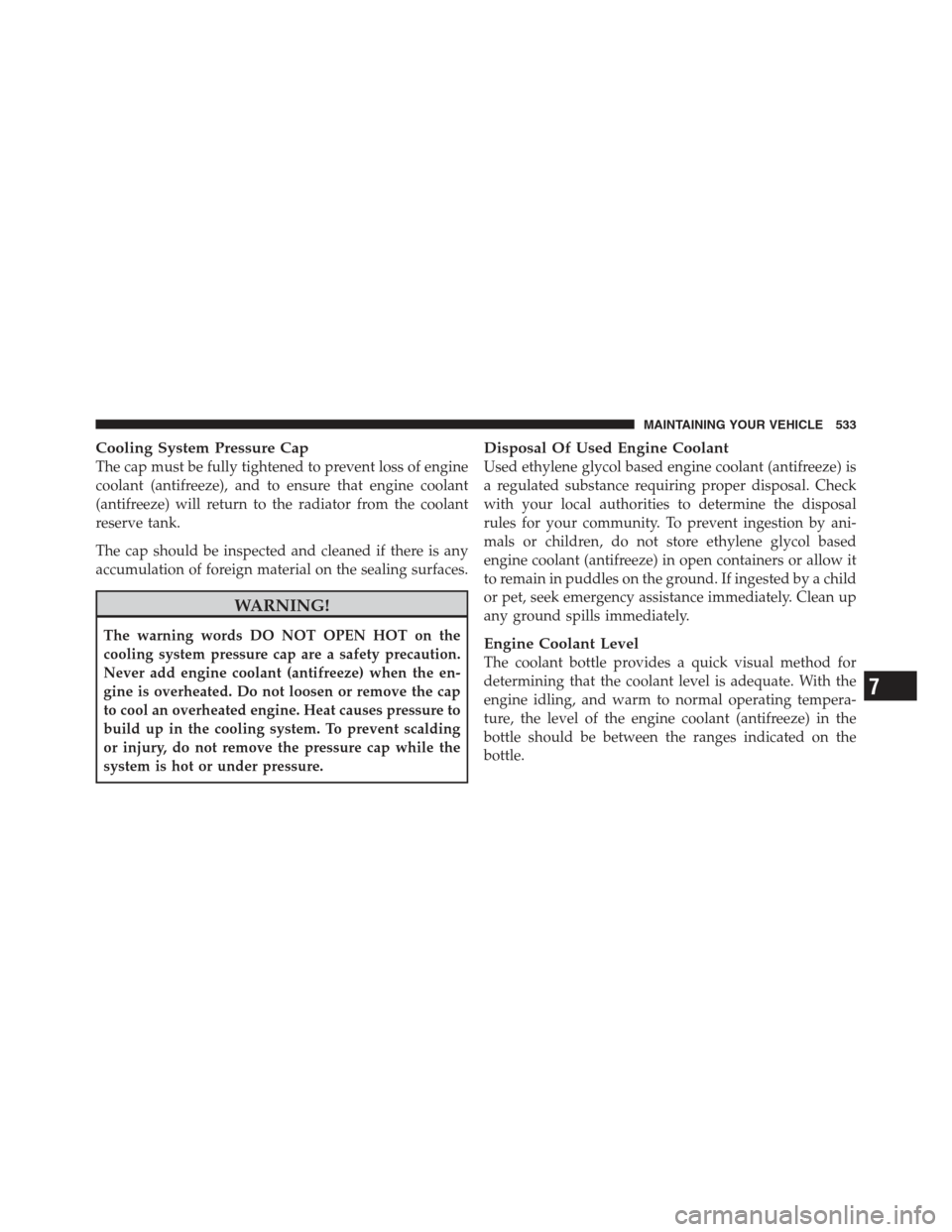
Cooling System Pressure Cap
The cap must be fully tightened to prevent loss of engine
coolant (antifreeze), and to ensure that engine coolant
(antifreeze) will return to the radiator from the coolant
reserve tank.
The cap should be inspected and cleaned if there is any
accumulation of foreign material on the sealing surfaces.
WARNING!
The warning words DO NOT OPEN HOT on the
cooling system pressure cap are a safety precaution.
Never add engine coolant (antifreeze) when the en-
gine is overheated. Do not loosen or remove the cap
to cool an overheated engine. Heat causes pressure to
build up in the cooling system. To prevent scalding
or injury, do not remove the pressure cap while the
system is hot or under pressure.
Disposal Of Used Engine Coolant
Used ethylene glycol based engine coolant (antifreeze) is
a regulated substance requiring proper disposal. Check
with your local authorities to determine the disposal
rules for your community. To prevent ingestion by ani-
mals or children, do not store ethylene glycol based
engine coolant (antifreeze) in open containers or allow it
to remain in puddles on the ground. If ingested by a child
or pet, seek emergency assistance immediately. Clean up
any ground spills immediately.
Engine Coolant Level
The coolant bottle provides a quick visual method for
determining that the coolant level is adequate. With the
engine idling, and warm to normal operating tempera-
ture, the level of the engine coolant (antifreeze) in the
bottle should be between the ranges indicated on the
bottle.
7
MAINTAINING YOUR VEHICLE 533
Page 536 of 613
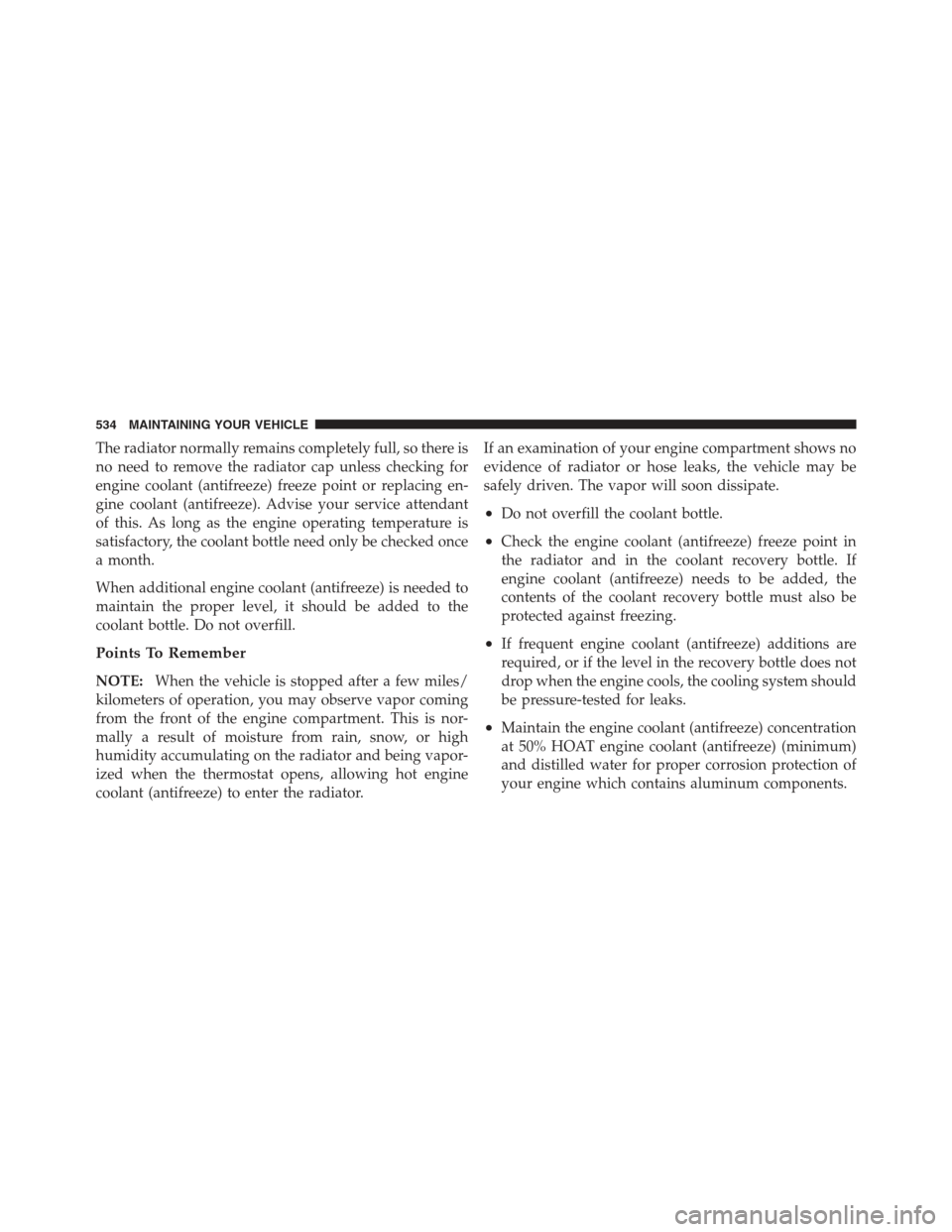
The radiator normally remains completely full, so there is
no need to remove the radiator cap unless checking for
engine coolant (antifreeze) freeze point or replacing en-
gine coolant (antifreeze). Advise your service attendant
of this. As long as the engine operating temperature is
satisfactory, the coolant bottle need only be checked once
a month.
When additional engine coolant (antifreeze) is needed to
maintain the proper level, it should be added to the
coolant bottle. Do not overfill.
Points To Remember
NOTE:When the vehicle is stopped after a few miles/
kilometers of operation, you may observe vapor coming
from the front of the engine compartment. This is nor-
mally a result of moisture from rain, snow, or high
humidity accumulating on the radiator and being vapor-
ized when the thermostat opens, allowing hot engine
coolant (antifreeze) to enter the radiator. If an examination of your engine compartment shows no
evidence of radiator or hose leaks, the vehicle may be
safely driven. The vapor will soon dissipate.
•Do not overfill the coolant bottle.
•Check the engine coolant (antifreeze) freeze point in
the radiator and in the coolant recovery bottle. If
engine coolant (antifreeze) needs to be added, the
contents of the coolant recovery bottle must also be
protected against freezing.
•If frequent engine coolant (antifreeze) additions are
required, or if the level in the recovery bottle does not
drop when the engine cools, the cooling system should
be pressure-tested for leaks.
•Maintain the engine coolant (antifreeze) concentration
at 50% HOAT engine coolant (antifreeze) (minimum)
and distilled water for proper corrosion protection of
your engine which contains aluminum components.
534 MAINTAINING YOUR VEHICLE
Page 538 of 613
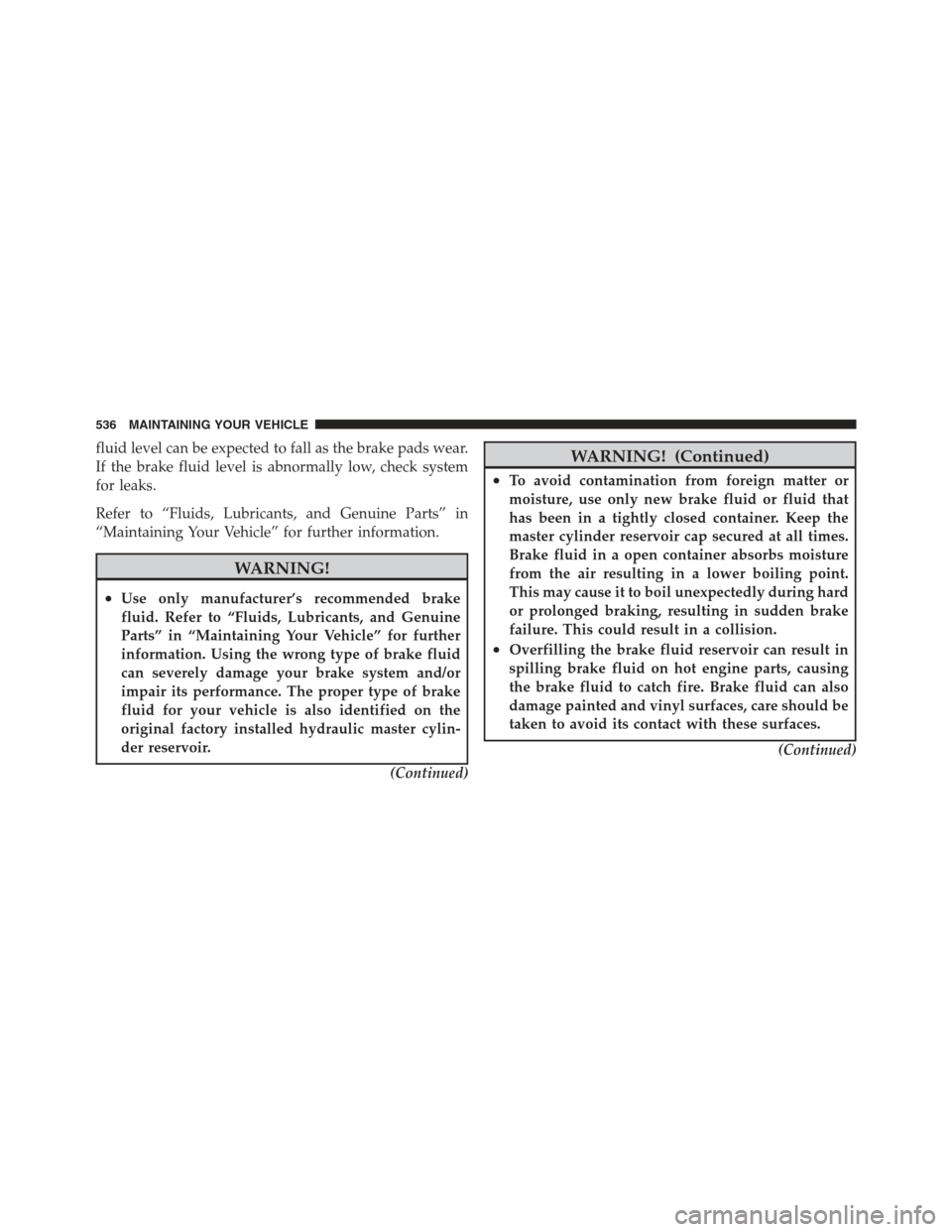
fluid level can be expected to fall as the brake pads wear.
If the brake fluid level is abnormally low, check system
for leaks.
Refer to “Fluids, Lubricants, and Genuine Parts” in
“Maintaining Your Vehicle” for further information.
WARNING!
•Use only manufacturer’s recommended brake
fluid. Refer to “Fluids, Lubricants, and Genuine
Parts” in “Maintaining Your Vehicle” for further
information. Using the wrong type of brake fluid
can severely damage your brake system and/or
impair its performance. The proper type of brake
fluid for your vehicle is also identified on the
original factory installed hydraulic master cylin-
der reservoir.(Continued)
WARNING! (Continued)
•To avoid contamination from foreign matter or
moisture, use only new brake fluid or fluid that
has been in a tightly closed container. Keep the
master cylinder reservoir cap secured at all times.
Brake fluid in a open container absorbs moisture
from the air resulting in a lower boiling point.
This may cause it to boil unexpectedly during hard
or prolonged braking, resulting in sudden brake
failure. This could result in a collision.
•Overfilling the brake fluid reservoir can result in
spilling brake fluid on hot engine parts, causing
the brake fluid to catch fire. Brake fluid can also
damage painted and vinyl surfaces, care should be
taken to avoid its contact with these surfaces.(Continued)
536 MAINTAINING YOUR VEHICLE
Page 540 of 613

CAUTION!
Do not use chemical flushes in your transmission as
the chemicals can damage your transmission compo-
nents. Such damage is not covered by the New
Vehicle Limited Warranty.
Fluid Level Check
Check the fluid level while the transmission is at normal
operating temperature 180° F (82° C). This occurs after at
least 15 miles (25 km) of driving. At normal operating
temperature, the fluid cannot be held comfortably be-
tween the fingertips.
To properly check the automatic transmission fluid level,
the following procedure must be used:
1. Operate the engine at idle speed and normal operating
temperature.
2. The vehicle must be on level ground.3. Fully apply the parking brake.
4. Place the shift lever momentarily into each gear posi-
tion ending with the shift lever in PARK.
5. Remove the dipstick, wipe it clean and reinsert it until
seated.
6. Remove the dipstick again and note the fluid level on
both sides. The fluid level should be between the HOT
(upper) reference holes on the dipstick at normal operat-
ing temperature. Verify that a solid coating of oil is seen
on both sides of the dipstick. If the fluid is low, add as
required into the dipstick tube.
Do not overfill.After
adding any quantity of oil through the dipstick tube, wait
a minimum of two minutes for the oil to fully drain into
the transmission before rechecking the fluid level.
NOTE: If it is necessary to check the transmission below
the operating temperature, the fluid level should be
between the two cold (lower) holes on the dipstick with
538 MAINTAINING YOUR VEHICLE
Page 567 of 613
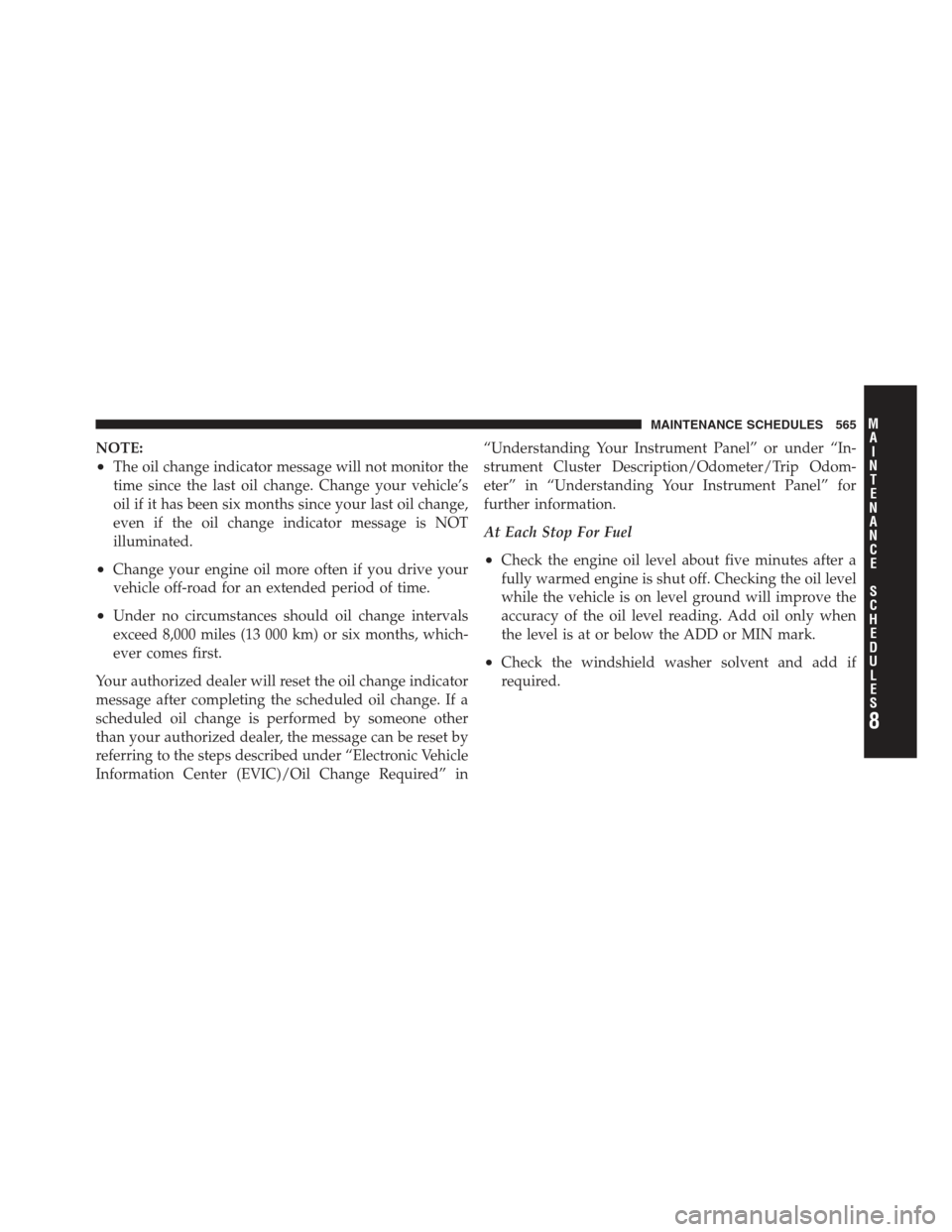
NOTE:
•The oil change indicator message will not monitor the
time since the last oil change. Change your vehicle’s
oil if it has been six months since your last oil change,
even if the oil change indicator message is NOT
illuminated.
•Change your engine oil more often if you drive your
vehicle off-road for an extended period of time.
•Under no circumstances should oil change intervals
exceed 8,000 miles (13 000 km) or six months, which-
ever comes first.
Your authorized dealer will reset the oil change indicator
message after completing the scheduled oil change. If a
scheduled oil change is performed by someone other
than your authorized dealer, the message can be reset by
referring to the steps described under “Electronic Vehicle
Information Center (EVIC)/Oil Change Required” in “Understanding Your Instrument Panel” or under “In-
strument Cluster Description/Odometer/Trip Odom-
eter” in “Understanding Your Instrument Panel” for
further information.
At Each Stop For Fuel
•Check the engine oil level about five minutes after a
fully warmed engine is shut off. Checking the oil level
while the vehicle is on level ground will improve the
accuracy of the oil level reading. Add oil only when
the level is at or below the ADD or MIN mark.
•Check the windshield washer solvent and add if
required.
8
M
A I
N T
E
N A
N CE
S
C
H E
D
U L
E
SMAINTENANCE SCHEDULES 565
Page 568 of 613

Once A Month
•Check tire pressure and look for unusual wear or
damage.
•Inspect the battery and clean and tighten the terminals
as required.
•Check the fluid levels of coolant reservoir, brake
master cylinder, power steering and transmission and
add as needed.
•Check all lights and other electrical items for correct
operation.At Each Oil Change
•Change the engine oil filter.
•Inspect the brake hoses and lines.
•Check the manual transmission fluid level.
CAUTION!
Failure to perform the required maintenance items
may result in damage to the vehicle.
Required Maintenance Intervals
Refer to the Maintenance Schedules on the following
pages for the required maintenance intervals.
8
M
A I
N T
E
N A
N CE
S
C
H E
D
U L
E
S566 MAINTENANCE SCHEDULES
Page 594 of 613
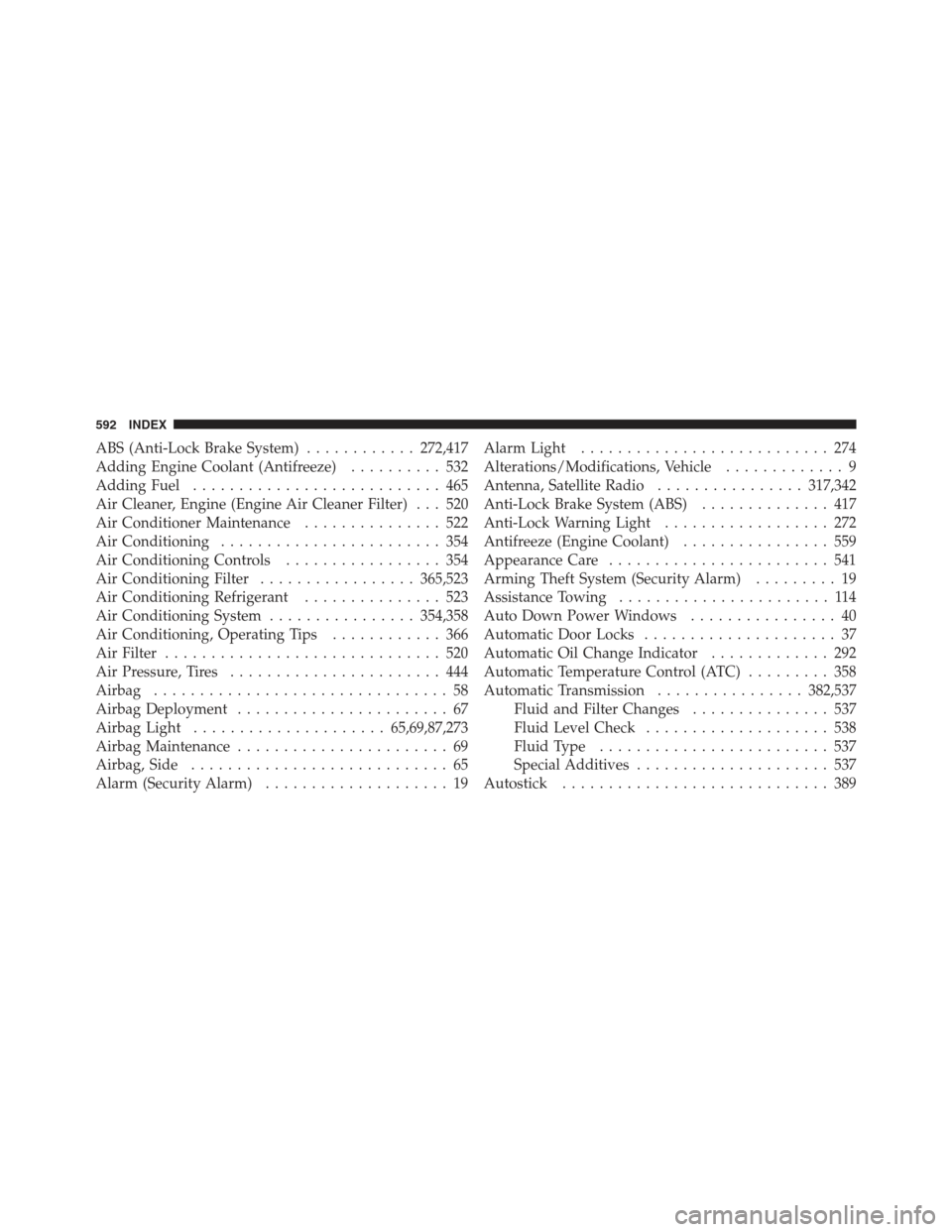
ABS (Anti-Lock Brake System)............272,417
Adding Engine Coolant (Antifreeze) .......... 532
Adding Fuel ........................... 465
Air Cleaner, Engine (Engine Air Cleaner Filter) . . . 520
Air Conditioner Maintenance ............... 522
Air Conditioning ........................ 354
Air Conditioning Controls ................. 354
Air Conditioning Filter .................365,523
Air Conditioning Refrigerant ............... 523
Air Conditioning System ................354,358
Air Conditioning, Operating Tips ............ 366
Air Filter .............................. 520
Air Pressure, Tires ....................... 444
Airbag ................................ 58
Airbag Deployment ....................... 67
Airbag Light ..................... 65,69,87,273
Airbag Maintenance ....................... 69
Airbag, Side ............................ 65
Alarm (Security Alarm) .................... 19 Alarm Light
........................... 274
Alterations/Modifications, Vehicle ............. 9
Antenna, Satellite Radio ................317,342
Anti-Lock Brake System (ABS) .............. 417
Anti-Lock Warning Light .................. 272
Antifreeze (Engine Coolant) ................ 559
Appearance Care ........................ 541
Arming Theft System (Security Alarm) ......... 19
Assistance Towing ....................... 114
Auto Down Power Windows ................ 40
Automatic Door Locks ..................... 37
Automatic Oil Change Indicator ............. 292
Automatic Temperature Control (ATC) ......... 358
Automatic Transmission ................382,537
Fluid and Filter Changes ............... 537
Fluid Level Check .................... 538
Fluid Type ......................... 537
Special Additives ..................... 537
Autostick ............................. 389
592 INDEX
Page 595 of 613
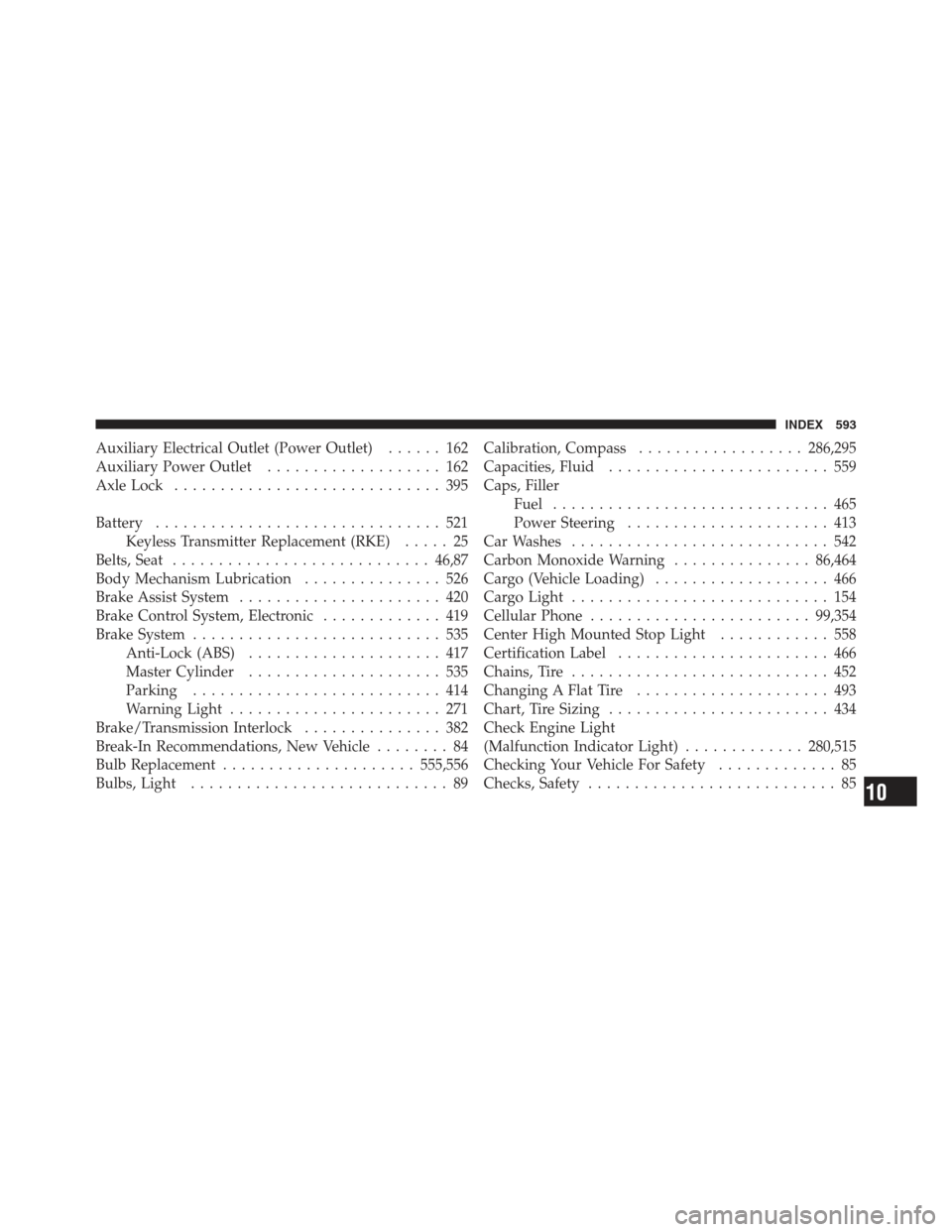
Auxiliary Electrical Outlet (Power Outlet)...... 162
Auxiliary Power Outlet ................... 162
Axle Lock ............................. 395
Battery ............................... 521
Keyless Transmitter Replacement (RKE) ..... 25
Belts, Seat ............................ 46,87
Body Mechanism Lubrication ............... 526
Brake Assist System ...................... 420
Brake Control System, Electronic ............. 419
Brake System ........................... 535
Anti-Lock (ABS) ..................... 417
Master Cylinder ..................... 535
Parking ........................... 414
Warning Light ....................... 271
Brake/Transmission Interlock ............... 382
Break-In Recommendations, New Vehicle ........ 84
Bulb Replacement ..................... 555,556
Bulbs, Light ............................ 89 Calibration, Compass
.................. 286,295
Capacities, Fluid ........................ 559
Caps, Filler Fuel .............................. 465
Power Steering ...................... 413
Car Washes ............................ 542
Carbon Monoxide Warning ...............86,464
Cargo (Vehicle Loading) ................... 466
Cargo Light ............................ 154
Cellular Phone ........................ 99,354
Center High Mounted Stop Light ............ 558
Certification Label ....................... 466
Chains, Tire ............................ 452
Changing A Flat Tire ..................... 493
Chart, Tire Sizing ........................ 434
Check Engine Light
(Malfunction Indicator Light) .............280,515
Checking Your Vehicle For Safety ............. 85
Checks, Safety ........................... 85
10
INDEX 593
Page 599 of 613
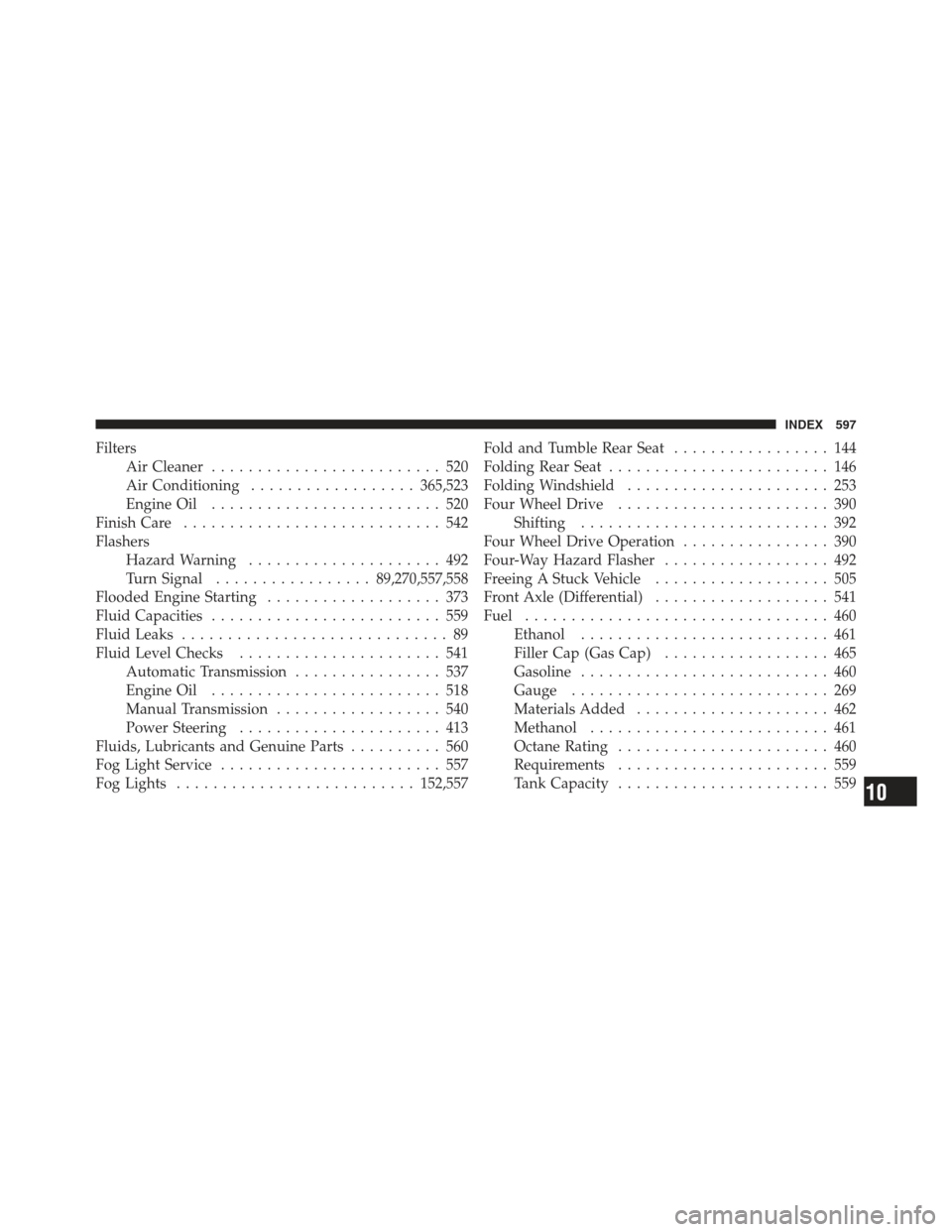
FiltersAir Cleaner ......................... 520
Air Conditioning .................. 365,523
Engine Oil ......................... 520
Finish Care ............................ 542
Flashers Hazard Warning ..................... 492
Turn Signal ................. 89,270,557,558
Flooded Engine Starting ................... 373
Fluid Capacities ......................... 559
Fluid Leaks ............................. 89
Fluid Level Checks ...................... 541
Automatic Transmission ................ 537
Engine Oil ......................... 518
Manual Transmission .................. 540
Power Steering ...................... 413
Fluids, Lubricants and Genuine Parts .......... 560
Fog Light Service ........................ 557
Fog Lights .......................... 152,557Fold and Tumble Rear Seat
................. 144
Folding Rear Seat ........................ 146
Folding Windshield ...................... 253
Four Wheel Drive ....................... 390
Shifting ........................... 392
Four Wheel Drive Operation ................ 390
Four-Way Hazard Flasher .................. 492
Freeing A Stuck Vehicle ................... 505
Front Axle (Differential) ................... 541
Fuel ................................. 460
Ethanol ........................... 461
Filler Cap (Gas Cap) .................. 465
Gasoline ........................... 460
Gauge ............................ 269
Materials Added ..................... 462
Methanol .......................... 461
Octane Rating ....................... 460
Requirements ....................... 559
Tank Capacity ....................... 559
10
INDEX 597